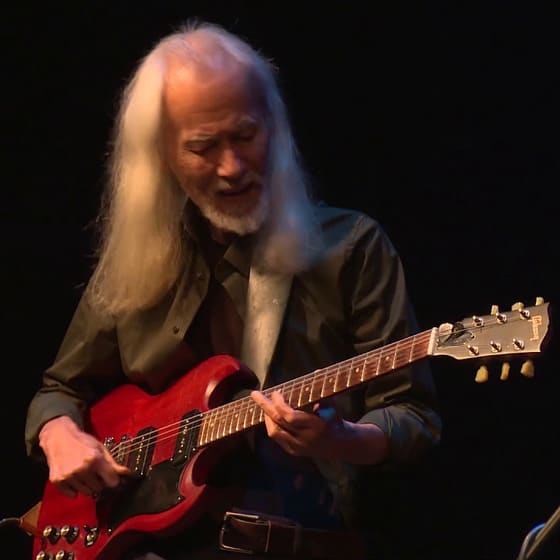Ryo Kawasaki — a Japanese guitarist, composer and inventor recognized as a pioneer of the fusion genre — has died. Kawasaki's passing was confirmed by both Estonia broadcaster ERR and his daughter, Tane Kawasaki Saavedra, in a Facebook post yesterday (April 13). He was 73.
Remembering her father, Saavedra recalled, "Falling asleep to the sound of [him] practicing. The smell of black coffee mingled with camel straights. American cheese omelettes at Westway and quiche at La Madeleine. The same song for weeks as [he] mixed it into perfection. Philosophical arguments that stretched from late nights into the wee hours of a morning saturated by beers and cigarettes."
She added, "My daddy. A true original. Just as your name suggests, you did illuminate, set it afire, and your fire will burn forever as your music plays on and we continue to carry your light. I love you. Ciao Papa."
Born in Tokyo in 1947, Kawasaki began taking voice lessons at age four and violin lessons at five, and was reading music before elementary school. An early fascination with electronics also saw him build his own radios, amplifiers and more, and he would eventually play a major role in his artistic achievements.
After buying a ukulele at age 10, Kawasaki purchased his first acoustic guitar at 14. He was inspired to study jazz music after hearing Kenny Burrell's 1963 album Midnight Blue and co-founded an ensemble of his own in high school.
After earning a Bachelor of Science degree at Nippon University, Kawasaki released solo debut Easy Listening Jazz Guitar through Polydor in 1970. He would continue working as a session musician on advertising jingles, pop songs and more ahead of releasing sophomore LP Guts the Guitar in 1972.
A move to New York in 1973 would lead to more exposure for Kawasaki. Revered pianist and band leader Gil Evans would invite him to join his Gil Evans Orchestra, with Kawasaki contributing to the group's 1974 album The Gil Evans Orchestra Plays the Music of Jimi Hendrix.
Kawasaki would continue to perform with the likes of Evans, Bobbi Humphrey, Dave Liebman, drummer Tony Williams and Chico Hamilton ahead of making his stateside debut with 1976's Juice. Album cut "Bamboo Child" has been famously sampled by Puff Daddy, Kool G Rap and Diamond D and the Psychotic Neurotics.
In 1979, Kawasaki invented his own guitar synthesizer and used it both in live performance and studio recordings between 1980 and 1983. Upon the launch of the Commodore 64 personal computer in the early '80s, Kawasaki developed a series of early music software programs: Kawasaki Synthesizer, Kawasaki Rhythm Rocker, Kawasaki Magical Musicquill and Kawasaki MIDI Workstation.
In the late '80s and early '90s, Kawasaki began a brief foray into electronic music, releasing a string of self-produced dance singles through his own label Satellites Records.
Kawasaki would continue to record jazz music as a bandleader and sideman throughout his life, releasing acoustic covers set Giant Steps and live album Level 8 Live last year. His final album of original material was 2017's Level 8.
Remembering her father, Saavedra recalled, "Falling asleep to the sound of [him] practicing. The smell of black coffee mingled with camel straights. American cheese omelettes at Westway and quiche at La Madeleine. The same song for weeks as [he] mixed it into perfection. Philosophical arguments that stretched from late nights into the wee hours of a morning saturated by beers and cigarettes."
She added, "My daddy. A true original. Just as your name suggests, you did illuminate, set it afire, and your fire will burn forever as your music plays on and we continue to carry your light. I love you. Ciao Papa."
Born in Tokyo in 1947, Kawasaki began taking voice lessons at age four and violin lessons at five, and was reading music before elementary school. An early fascination with electronics also saw him build his own radios, amplifiers and more, and he would eventually play a major role in his artistic achievements.
After buying a ukulele at age 10, Kawasaki purchased his first acoustic guitar at 14. He was inspired to study jazz music after hearing Kenny Burrell's 1963 album Midnight Blue and co-founded an ensemble of his own in high school.
After earning a Bachelor of Science degree at Nippon University, Kawasaki released solo debut Easy Listening Jazz Guitar through Polydor in 1970. He would continue working as a session musician on advertising jingles, pop songs and more ahead of releasing sophomore LP Guts the Guitar in 1972.
A move to New York in 1973 would lead to more exposure for Kawasaki. Revered pianist and band leader Gil Evans would invite him to join his Gil Evans Orchestra, with Kawasaki contributing to the group's 1974 album The Gil Evans Orchestra Plays the Music of Jimi Hendrix.
Kawasaki would continue to perform with the likes of Evans, Bobbi Humphrey, Dave Liebman, drummer Tony Williams and Chico Hamilton ahead of making his stateside debut with 1976's Juice. Album cut "Bamboo Child" has been famously sampled by Puff Daddy, Kool G Rap and Diamond D and the Psychotic Neurotics.
In 1979, Kawasaki invented his own guitar synthesizer and used it both in live performance and studio recordings between 1980 and 1983. Upon the launch of the Commodore 64 personal computer in the early '80s, Kawasaki developed a series of early music software programs: Kawasaki Synthesizer, Kawasaki Rhythm Rocker, Kawasaki Magical Musicquill and Kawasaki MIDI Workstation.
In the late '80s and early '90s, Kawasaki began a brief foray into electronic music, releasing a string of self-produced dance singles through his own label Satellites Records.
Kawasaki would continue to record jazz music as a bandleader and sideman throughout his life, releasing acoustic covers set Giant Steps and live album Level 8 Live last year. His final album of original material was 2017's Level 8.
